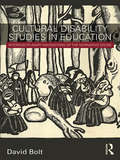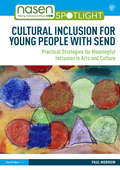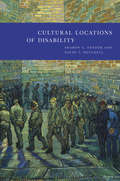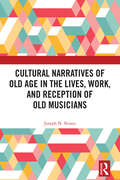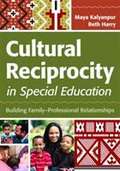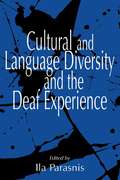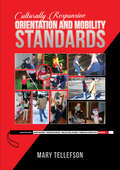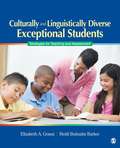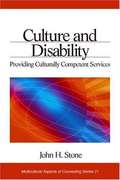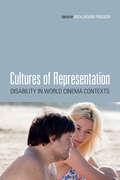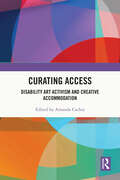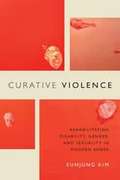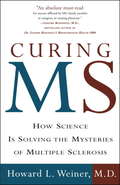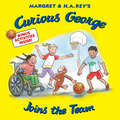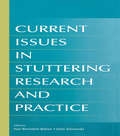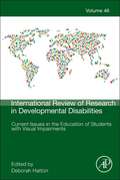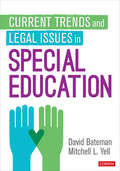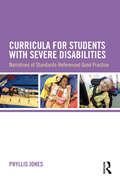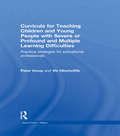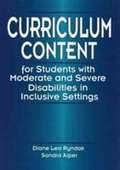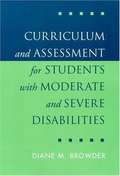- Table View
- List View
Cultural Disability Studies in Education: Interdisciplinary Navigations of the Normative Divide (Routledge Advances in Disability Studies)
by David BoltOver the last few decades disability studies has emerged not only as a discipline in itself but also as a catalyst for cultural disability studies and Disability Studies in Education. In this book the three areas become united in a new field that recognises education as a discourse between tutors and students who explore representations of disability on the levels of everything from academic disciplines and knowledge to language and theory; from received understandings and social attitudes to narrative and characterisation. Moving from late nineteenth to early twenty-first-century representations, this book combines disability studies with aesthetics, film studies, Holocaust studies, gender studies, happiness studies, popular music studies, humour studies, and media studies. In so doing it encourages discussion around representations of disability in drama, novels, films, autobiography, short stories, music videos, sitcoms, and advertising campaigns. Discussions are underpinned by the tripartite model of disability and so disrupt one-dimensional representations. Cultural Disability Studies in Education encourages educators and students to engage with disability as an isolating, hurtful, and joyful experience that merits multiple levels of representation and offers true potential for a non-normative social aesthetic. It will be required reading for all scholars and students of disability studies, cultural disability studies, Disability Studies in Education, sociology, and cultural studies.
Cultural Inclusion for Young People with SEND: Practical Strategies for Meaningful Inclusion in Arts and Culture (nasen spotlight)
by Paul MorrowThis practical book offers a multifaceted view of cultural inclusion from the perspective of special educational needs and disabilities (SEND). It provides a road map for teachers to ensure increased participation in arts and culture for children and young people with SEND, defining a series of characteristics for good practice. Chapters explore spaces as diverse as galleries, museums, theatres and performance venues and include a variety of case studies, highlighting the experiences of young people and the organisations who partner with schools. Cultural Inclusion for Young People with SEND offers a compelling call to action and is an essential resource for those who have the power to improve and support the development of future provision for children with SEND.
Cultural Locations of Disability
by David T. Mitchell Sharon L. SnyderIn Cultural Locations of Disability, Sharon L. Snyder and David T. Mitchell trace how disabled people came to be viewed as biologically deviant. The eugenics era pioneered techniques that managed "defectives" through the application of therapies, invasive case histories, and acute surveillance techniques, turning disabled persons into subjects for a readily available research pool. In its pursuit of normalization, eugenics implemented disability regulations that included charity systems, marriage laws, sterilization, institutionalization, and even extermination. Enacted in enclosed disability locations, these practices ultimately resulted in expectations of segregation from the mainstream, leaving today's disability politics to focus on reintegration, visibility, inclusion, and the right of meaningful public participation. Snyder and Mitchell reveal cracks in the social production of human variation as aberrancy. From our modern obsessions with tidiness and cleanliness to our desire to attain perfect bodies, notions of disabilities as examples of human insufficiency proliferate. These disability practices infuse more general modes of social obedience at work today. Consequently, this important study explains how disabled people are instrumental to charting the passage from a disciplinary society to one based upon regulation of the self.
Cultural Narratives of Old Age in the Lives, Work, and Reception of Old Musicians
by Joseph StrausOperating largely within the world of European-American classical music, this book discusses the creative work of old musicians—composers, performers, listeners, and scholars—and how those forms of music- making are received and understood. Like everything else about old age, music-making is usually understood as a decline from a former height, a deficiency with respect to a youthful standard. Against this ageist mythology, this book argues that composing oldly, performing oldly, and listening oldly are distinctive and valuable ways of making music—a difference, not a deficit; to be celebrated, not ignored or condemned.Instead of the usual biomedical or gerontological understanding of old age, with its focus on bodily, cognitive, and sensory decline, this book follows Age Studies in seeing old age through a cultural lens, as something created and understood in culture. This book seeks to identify the ways that old musicians (composers, performers, listeners, and scholars) accept, resist, adapt, and transform the cultural scripts for the performance of old age. Musicking oldly (making music in old age) often represents an attempt to rewrite ageist cultural scripts and to find ways of flourishing musically in a largely hostile landscape.
Cultural Reciprocity in Special Education: Building Family-Professional Relationships
by Maya Kalyanpur Beth HarryTo succeed in increasingly diverse classrooms, tomorrow's special educators need explicit training on working effectively with all families. Prepare the next generation of teachers with this accessible text, developed by two highly respected experts on cultural and linguistic diversity and inclusive education. Ideal for use as a supplementary textbook in a wide range of courses related to special education, this book gives educators a practical framework for cultural reciprocity a process that helps professionals and families examine their own values, respect each other's differences, and collaborate skillfully to benefit children. <p><p> To give special educators a deeper, more nuanced understanding of cultural reciprocity, the text also includes three chapter-long case studies that further illustrate the process at work. Readers will learn from the challenges and successes of an African American researcher working with a group of teenage mothers; two teacher educators collaborating on the Special Educators Entering a Diverse Society (SEEDS) project; and an Asian Indian teacher educator leading a class of mostly Caucasian students. A key text for future special educators and a valuable resource for in service training this book will help teachers build strong collaborative relationships with diverse families and ensure that all children receive the best possible education.
Cultural and Language Diversity and the Deaf Experience
by Ila ParasnisThis edited volume provides a comprehensive analysis of deaf people as a culturally and linguistically distinct minority group within American society. Many educators, linguists, and researchers now favor this position, as opposed to that which states that a deaf person simply has an audiological disability. Contributors to this book include members of the deaf community, as well as prominent deaf and hearing educators and researchers. The text contains three sections, covering research on bilingualism and biculturalism, the impact of cultural and language diversity on the deaf experience, and first-hand accounts from deaf community members that highlight the emotional impact of living in the deaf and hearing worlds.
Culturally Proficient Inclusive Schools: All Means ALL!
by Delores B. Lindsey Jacqueline S. Thousand Cynthia L. Jew Lori R. PiowlskiCreate inclusive educational environments that benefit ALL learners! As schools become more diverse with students of differing abilities and needs, this self-reflective and action-oriented guide helps you create and support more inclusive schools and classrooms that intentionally educate all students. Using the Five Essential Elements of Cultural Proficiency as a roadmap, this book presents: Students’ learning differences as just that – differences rather than deficits Strategies that show you how to break though the common barriers to culturally proficient and inclusive schooling Assessments that gauge your awareness and show you how to best serve every student’s needs
Culturally Proficient Inclusive Schools: All Means ALL!
by Delores B. Lindsey Jacqueline S. Thousand Cynthia L. Jew Lori R. PiowlskiCreate inclusive educational environments that benefit ALL learners! As schools become more diverse with students of differing abilities and needs, this self-reflective and action-oriented guide helps you create and support more inclusive schools and classrooms that intentionally educate all students. Using the Five Essential Elements of Cultural Proficiency as a roadmap, this book presents: Students’ learning differences as just that – differences rather than deficits Strategies that show you how to break though the common barriers to culturally proficient and inclusive schooling Assessments that gauge your awareness and show you how to best serve every student’s needs
Culturally Responsive Orientation and Mobility Standards
by Mary TellefsonAt last! The field of Orientation and Mobility (O&M) embraces the 21st Century Model for standards-based instruction with these research-based, peer-reviewed, and validated performance standards that correlate to success in career, college and community life.Commensurate with general education curriculum, these learner performance standards give important credibility to O&M instruction by providing measurable, age-appropriate and culturally responsive outcome targets to guide assessment and instruction. For those who don&’t understand what O&M is and for those who fund it, the O&M CCCRS clearly articulate and justify a learner&’s need for instruction, justify a level of service needed to meet age-appropriate performance targets and justify the tools need to do the job. This is a must resource for master and novel-level instructors alike.
Culturally and Linguistically Diverse Exceptional Students: Strategies for Teaching and Assessment
by Elizabeth A. Grassi Heidi Bulmahn BarkerConnects theory to practice while presenting foundational teaching and assessment practices for CLDE students. Practical in nature and designed with an eye toward universal design for learning, this text brings together foundational information from special education and ELL/bilingual fields to help teachers address the specific needs of culturally and linguistically diverse exceptional (CLDE) students. Key Features: Case studies from teachers, students, and parents describe the personal challenges of CLDE students. Authentic student language examples illustrate the concepts described and make practical connections to the research discussed Activities for further understanding allow students to review key points and connects theory to classroom practice. Ancillaries available at www. sagepub. com/grassi Password-protected instructor resources include PowerPoint lecture slides, sample syllabi, and Web resources. An open-access student study site provides online video clips of teachers in action, which exemplify different strategies and are accompanied by critical thinking questions from the authors. Students can also access additional case studies and relevant SAGE journal articles from the study site.
Culture And Disability: Providing Culturally Competent Services
by John H. StoneCulture and Disability is a groundbreaking work on persons with disabilities from diverse immigrant backgrounds. It is a pioneering and practical volume dealing with topics that have been too long ignored. Using a 'cultural broker' model and written by individuals who have emigrated to the U. S. from countries such as China, Korea, Jamaica, Mexico, and the Dominican Republic, Providing Cultural Competent Disability Services contains concrete examples, case studies, and recommendations that will help rehabilitation practitioners in their day-to-day activities. Providing Cultural Competent Disability Service also serves as an excellent supplemental text for undergraduate and graduate programs in rehabilitation and related disciplines.
Cultures of Representation: Disability in World Cinema Contexts (Toronto Iberic Ser.)
by Benjamin FraserCultures of Representation is the first book to explore the cinematic portrayal of disability in films from across the globe. Contributors explore classic and recent works from Belgium, France, Germany, India, Italy, Iran, Japan, Korea, Mexico, Netherlands, Russia, Senegal, and Spain, along with a pair of globally resonant Anglophone films. Anchored by David T. Mitchell and Sharon L. Snyder's coauthored essay on global disability-film festivals, the volume's content spans from 1950 to today, addressing socially disabling forces rendered visible in the representation of physical, developmental, cognitive, and psychiatric disabilities. Essays emphasize well-known global figures, directors, and industries – from Temple Grandin to Pedro Almodóvar, from Akira Kurosawa to Bollywood – while also shining a light on films from less frequently studied cultural locations such as those portrayed in the Iranian and Korean New Waves. Whether covering postwar Italy, postcolonial Senegal, or twenty-first century Russia, the essays in this volume will appeal to scholars, undergraduates, and general readers alike.
Curating Access: Disability Art Activism and Creative Accommodation
by Amanda CachiaThis book is an interdisciplinary collection of twenty-four essays which critically examine contemporary exhibitions and artistic practices that focus on conceptual and creative aspects of access. Oftentimes exhibitions tack on access once the artwork has already been executed and ready to be installed in the museum or gallery. But what if the artists were to ponder access as an integral and critical part of their artwork? Can access be creative and experimental? And furthermore, can the curator also fold access into their practice, while working collaboratively with artists, considering it as a theoretical and practical generative force that seeks to make an exhibition more engaging for a wider diversity of audiences? This volume includes essays by a growing number of artists, curators, and scholars who ponder these ideas of ad-hoc, experimental and underground approaches within exhibition-making and artistic practices. It considers how, through these nascent exhibition models and art practices, enhanced experiences of access in the museum can be a shared responsibility amongst museum workers, curators, and artists, in tandem with the public, so that access becomes a zone of intellectual and creative "accommodation," rather than strictly a discourse on policy. The book provides innovative case studies which provide a template for how access might be implemented by individuals, artists, curators, museum administrators and educators given the growing need to offer as many modalities of access as possible within cultural institutions. This book shows that anyone can be a curator of access and demonstrates how to approach access in a way that goes beyond protocol and policy. It will thus be of interest to students and scholars engaged in the study of museums, art history and visual culture, disability, culture, and communication.
Curative Violence: Rehabilitating Disability, Gender, and Sexuality in Modern Korea
by Eunjung KimIn Curative Violence Eunjung Kim examines what the social and material investment in curing illnesses and disabilities tells us about the relationship between disability and Korean nationalism. Kim uses the concept of curative violence to question the representation of cure as a universal good and to understand how nonmedical and medical cures come with violent effects that are not only symbolic but also physical. Writing disability theory in a transnational context, Kim tracks the shifts from the 1930s to the present in the ways that disabled bodies and narratives of cure have been represented in Korean folktales, novels, visual culture, media accounts, policies, and activism. Whether analyzing eugenics, the management of Hansen's disease, discourses on disabled people's sexuality, violence against disabled women, or rethinking the use of disabled people as a metaphor for life under Japanese colonial rule or under the U.S. military occupation, Kim shows how the possibility of life with disability that is free from violence depends on the creation of a space and time where cure is seen as a negotiation rather than a necessity.
Curing MS: How Science Is Solving the Mysteries of Multiple Sclerosis
by Howard L. WeinerWhat causes multiple sclerosis? When will there be a cure? Dr. Howard Weiner has spent nearly three decades trying to find answers to the mysteries of multiple sclerosis, an utterly confounding and debilitating disease that afflicts almost half a million Americans. Curing MS is his moving, personal account of the long-term scientific quest to pinpoint the origins of the disease and to find a breakthrough treatment for its victims. Dr. Weiner has been at the cutting edge of MS research and drug development, and he describes in clear and illuminating detail the science behind the symptoms and how new drugs may hold the key to "taming the monster." From the "Twenty-one Points" of MS--a concise breakdown of the knowns and unknowns of the disease--to stories from the frontlines of laboratories and hospitals, Curing MS offers a message of hope about new treatments and makes a powerful argument that a cure can--and will--be found.
Curious George Joins the Team (Curious George)
by H. A. ReyCurious George has a playdate at a park designed for children of all abilities, perfect for his new friend, Tina, who uses a wheelchair. While they are playing together, Tina spots some kids playing her favorite game: basketball. George jumps right into the action, but Tina is too shy to ask to join. George suspects Tina is just as good--even better--than the other kids. Can he come up with a way to show the players she's got game and help her overcome her shyness? This story celebrates how kids of all abilities can play together!
Current Issues in Stuttering Research and Practice
by Nan Bernstein Ratner John TetnowskiThis state-of-the art volume is a follow-up to the 1999 publication, Stuttering Research and Practice: Bridging the Gap, edited by Nan Ratner and E. Charles Healey. Like its predecessor, the current book is an edited collection of the presentations from the American Speech-Language-Hearing Association’s Annual Leadership Conference in Fluency and Fluency Disorders. Among the topics covered are evidence-based practice, impact of the self-help and support groups, meta-analyses of selected assessment and intervention programs, current theories of stuttering, and the predicted path of stuttering intervention in the future. The authoritative representation of contributors offers the reader the most up to date presentation of fluency issues, with a special emphasis placed on the practical clinical implications of fluency assessment, treatment, and evolving theories of the disorder. The book is written for fluency specialists and graduate students in programs of fluency disorders. It will also be valuable for the clinicians who wish to upgrade their skills in treating fluency disorders.
Current Issues in the Education of Students with Visual Impairments (International Review of Research in Developmental Disabilities, Volume #46)
by Deborah D. HattonThis edition addresses current issues in the education of students with visual impairments and includes the expanded core curriculum for students with visual impairment, assistive technology, Braille reading comprehension, communication development, orientation and mobility issues, and more.
Current Trends and Legal Issues in Special Education
by Mitchell L. Yell David F. BatemanBuilding and supporting effective special education programs School leaders and special educators are expected to be experts on all levels and types of special education law and services, types of disability, and aspects of academic and functional programming. With the increasing demands of the job and the ever-changing legal and educational climate, many administrators and teachers are overwhelmed, and few feel adequately prepared to meet the demands. Trends and Legal Issues in Special Education helps you build and support timely, legally sound, and effective special education services and programs. Readers will find: the most up-to-date information on how to effectively implement special education programs, processes, and procedures examination of a wide variety of issues, from developing and implementing individual education programs (IEPs) that confer a free appropriate public education, Section 504, least restrictive environment (LRE), and successfully collaborating with parents, to issues regarding accountability, staffing, bullying, early childhood special education, multi-tiered systems of support (MTSS), evidence-based practices, transition, discipline, and the school-to-prison pipeline extensive references and resources Written as a comprehensive reference for all who work with students with disabilities, this book offers the most up-to-date research and field-tested strategies from a range of experts that special education professionals can confidently and immediately apply.
Current Trends and Legal Issues in Special Education
by Mitchell L. Yell David F. BatemanBuilding and supporting effective special education programs School leaders and special educators are expected to be experts on all levels and types of special education law and services, types of disability, and aspects of academic and functional programming. With the increasing demands of the job and the ever-changing legal and educational climate, many administrators and teachers are overwhelmed, and few feel adequately prepared to meet the demands. Trends and Legal Issues in Special Education helps you build and support timely, legally sound, and effective special education services and programs. Readers will find: the most up-to-date information on how to effectively implement special education programs, processes, and procedures examination of a wide variety of issues, from developing and implementing individual education programs (IEPs) that confer a free appropriate public education, Section 504, least restrictive environment (LRE), and successfully collaborating with parents, to issues regarding accountability, staffing, bullying, early childhood special education, multi-tiered systems of support (MTSS), evidence-based practices, transition, discipline, and the school-to-prison pipeline extensive references and resources Written as a comprehensive reference for all who work with students with disabilities, this book offers the most up-to-date research and field-tested strategies from a range of experts that special education professionals can confidently and immediately apply.
Curricula for Students with Severe Disabilities: Narratives of Standards-Referenced Good Practice
by Phyllis JonesStudents with severe disabilities comprise 2 percent of the population of learners who are impacted by intellectual, communicative, social, emotional, physical, sensory and medical issues. Increasingly, however, teachers are required to meet the challenges of creating a pedagogical balance between an individual student's strengths, needs and preferences, and core academic curricula. The need to embrace the current initiative of curriculum state standards in the debate of curricula relevance, breadth, balance and depth for students with severe disabilities is not just timely—it contributes to the evolving debate of what constitutes an appropriate curriculum for severely disabled learners. Curricula for Students with Severe Disabilities supports the development of greater understandings of the role that state curriculum standards play in the pedagogical decision-making for students with severe intellectual disabilities. The book first discusses the nature and needs of these students, the curriculum for this group of learners and the recent contributions of state curriculum standards, before presenting narratives of real classrooms, teachers and students who have meaningfully integrated state curriculum standards at the kindergarten, elementary and high school levels.
Curricula for Teaching Children and Young People with Severe or Profound and Multiple Learning Difficulties: Practical strategies for educational professionals (nasen spotlight)
by Peter Imray Viv HinchcliffeCurricula for Teaching Children and Young People with Severe or Profound and Multiple Learning Difficulties offers a range of compelling arguments for a distinct and separate pedagogical approach to the learning needs of the most educationally challenging pupils. This book, written in accessible, common sense and non-academic language, provides an easy-to-follow alternative curriculum specifically designed to enhance and enrich the learning of children with profound and multiple learning difficulties. Chapter by chapter, guidelines and support are offered in key curriculum areas, some of which include: Cognition Language, Literacy and Communication Mathematical Physical Sensory Creative Care Play Problem solving. This highly practical resource is essential reading for any educational professional, parents, school governors, teachers, teaching assistants, therapists and indeed anyone involved with maximising the educational opportunities of those with profound learning difficulties.
Curriculum Content for Students with Moderate and Severe Disabilities in Inclusive Settings
by Diane L. Ryndak Sandra K. AlperThis book provides a complete description of a process through which collaborative education teams can identify appropriate functional and general education curriculum content for readers with moderate or severe disabilities who are included in general education settings.
Curriculum and Assessment for Students with Moderate and Severe Disabilities
by Barbara Wilson Diane M. BrowderA guide to designing and implementing personalized curricula for students with moderate to severe disabilities. The assessment model described provides a framework for pinpointing educational priorities, planning instruction in specific areas, and evaluating student progress. Strategies presented are teacher-friendly and data-based, and emphasize the values of self-determination, multicultural awareness, and educational accountability. Includes case studies, sample assessments, inventories of key skills, and descriptions of instructional resources, plus reproducible forms. Browder teaches special education at the University of North Carolina-Charlotte Annotation c. Book News, Inc., Portland, OR (booknews.com)
Curriculum and Pedagogy in Inclusive Education: Values into practice
by Jonathan Rix Katy Simmons Kieron Sheehy Melanie NindWhile activists, politicians and policy-makers grapple with the big picture, teachers and learners are making inclusion happen in their day-to-day lives. This unique text shows the importance and reality of curriculum and pedagogy in developing inclusive practice in a range of settings.Bringing together an exemplary collection of key articles, this Reader provides ways of thinking about inclusive curricula and pedagogy as starting points for possible action, as wel as:* illustrating how teachers can get education right or wrong for diverse learners depending on the pedagogical decisions they make;* discussing the role of the ordinary, special and inclusive pedagogy;* showing examples of teaching that elicits genuine participation and active learning;* providing case studies, and lessons from learners about what makes good teaching for them.Curriculum and Pedagogy in Inclusive Education will be inspirational reading for anyone with an interest in making inclusion happen.
